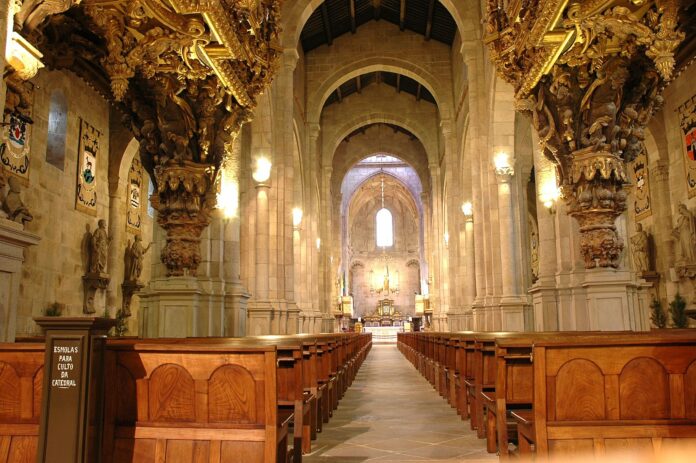Portugal is an incredibly rich country in terms of history and culture. Its territory is filled to the brim with awe-striking buildings that stand out as a testament to the country’s artistic identity!
Although Manueline is by far the most famous and sought-after style in the country, Romanesque architecture flourished in Portugal in the 12th century, so we definitely should not overlook it.
During that time, many Romanesque churches and monasteries were built. The development of this style was intertwined with the Portuguese participation in the Reconquista, which is why the buildings stand out not only as architectural monuments but also as significant historical landmarks.
Join us in this cultural journey of (re)discovering Portuguese Romanesque architecture!
Romanesque Architecture in Portugal
Romanesque architecture developed in medieval Europe, having been predominant in the 11th and 12th centuries. It preceded the Gothic style.
The Romanesque style has its roots in Roman techniques. It developed simultaneously in Italy, France, and the Iberian Peninsula.
In Portugal, the Romanesque was predominant in recently conquered regions. They were likely more open to influences. As such, even though Romanesque influences arrived in Portugal at the end of the 11th century, it wasn’t until the second quarter of the 12th century that the style actually became popular.
It is believed that the Reconquista – a series of military campaigns waged by Christian kingdoms against the Muslim kingdoms – caused the increased use of Romanesque techniques in Portugal.
The Reconquista took place from the North to the South. If one were to follow a route of Romanesque architecture in Portugal, they’d notice that the North is abundant in Romanesque buildings, whereas the South has fewer landmarks. More precisely, Romanesque churches are very common in the Northwest and the Center.
The expansion of the Romanesque also coincided with the territory’s reorganization since many new parishes appeared in the 12th and 13th centuries. The churches were considered “the consecrating pole of the entire parish,” so it was only natural that so many were built during that period.
Afonso Henriques, also known as Afonso I and the Conqueror, was the first king of Portugal. It was during his reign that some of the most iconic Portuguese Romanesque constructions were built.
During his reign, Portugal was adorned with the famous cathedrals in Lisbon, Coimbra, Viseu, and Porto, as well as with the Monastery of Santa Cruz. It’s worth noting, however, that many of the original Romanesque decorations were lost over time. The Monastery of Santa Cruz, for example, was fully Romanesque at first, displaying French Romanesque influences. Over the years, the decorations were destroyed or replaced. Today, it is largely Manueline.
Romanesque Architecture – Characteristics
Although predominantly a religious architecture, the Romanesque style was also used for:
- Townhouses
- Domestic buildings
- Military structures
- Palaces
- Commercial premises
- Castles
- City walls
- Bridges
Here are some characteristics that are typical of the Romanesque:
- Thick walls and small windows
- Rectangular piers that support arches
- Columns that serve for structural and decorative purposes
- Corinthian capitals (round at the bottom and square at the top, sitting on a circular column) that supported an arch or a wall
- Barrel, groin, ribbed, or pointed-arched vaults
- Octagonal domes with corner squinches (triangular corners that support the dome base)
- A Latin Cross plan
- Symmetrical facades with two tall towers on each side and deeply recessed openings
- A single portal placed on the west front
- Lombard band arcades (rows of small arches supporting a roofline)
- Aisles separated by arcades
- Larger monasteries may have three aisles supported by columns or piers
- Semicircular arches
- Geometrical decorations
- Figurative sculptures, particularly around cathedral and church portals; these are usually Biblical in subject or depict legends of local saints (particularly in Portugal) to teach people about virtues and sins; some Portuguese Romanesque buildings also feature mundane events, like musicians playing instruments, people dancing, or peasants planting crops.
- Mural decorations
- Stained glass
- Corbels featuring human or animal heads, as well as imaginary beasts
- Wooden roofs
- Cloisters (an open gallery or arcade) running along the building wall
Due to historical circumstances, Portuguese Romanesque churches have a unique trait – although they’re all quite similar at first glance, there are some dissimilarities between churches located in different regions.
These differences can be linked to political and geographical circumstances and external influences. All these distinguishable Romanesque styles are sometimes called dialects of the Portuguese Romanesque.
Romanesque Landmarks in Portugal
If you’re passionate about architecture or simply want to immerse yourself in Portugal’s history and culture, we strongly recommend adding these landmarks to your must-visit list!
1. Lisbon Cathedral
The Cathedral of Lisbon (Sé de Lisboa), located in the heart of the city, is its oldest church. It is among the most iconic Romanesque buildings in the country.
The cathedral was built in 1147. It has been restored multiple times, after having survived several earthquakes – some in the 14th and 16th centuries and, naturally, the infamous 1755 Lisbon earthquake. As a consequence, the building is now a combination of various architectural styles, although it was originally fully Romanesque.
The Cathedral of Lisbon has a Latin cross plan – it has three aisles, a transept (a transverse part that lies across the main body of the building), a main chapel, and an ambulatory that surrounds it.
With two towers flanking the entrance, the facade has a fortress-like appearance. The circular rose window stands out among all other elements adorning the facade. The portals are also decorated with capitals featuring Romanesque motifs.
At the end of the 13th century, some Gothic elements were added:
- A Gothic cloister (which was damaged during the 1755 earthquake)
- The Romanesque apse was replaced by a Gothic chapel (which was destroyed during the 1755 earthquake)
- The ambulatory was adorned with three Gothic tombs
Later on, during the 17th century, Sé de Lisboa was decorated with a Baroque sacristy. After the 1755 earthquake, the chapel acquired a neoclassical and Rococo appearance. In the 20th century, however, the neoclassical elements were removed.

2. Cathedral of Braga
The Cathedral of Braga was likely finished in the 13th century.
Back then, its Western facade was fully Romanesque. Today, however, it looks completely different except for some capitals and archivolts. The portal on the Southern facade retains Romanesque elements, particularly on the tympanum and columns. The interior of the church has three aisles.
Although the chapels were Romanesque in style at first, they were subsequently rebuilt. The main chapel acquired a Manueline style, and the others were adorned with Baroque elements. The small chapel on the outside of the cathedral was likely kept in its initial Romanesque form.
Over the centuries, the nave (the central part of the church) of the Cathedral of Braga underwent several changes in terms of style. However, all these upgrades were removed in the 20th century, so the nave is now fully Romanesque.
Today, the Cathedral of Braga has Romanesque, Gothic, Manueline, Moorish, and Baroque decorations.
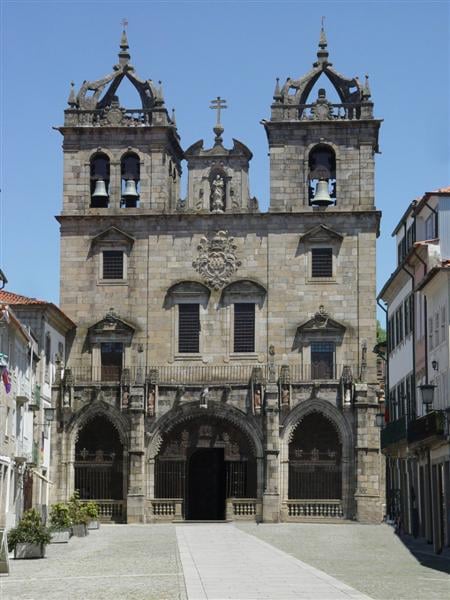
3. Porto Cathedral
The Cathedral of Porto is among the country’s most significant Romanesque treasures. Its construction began in the 12th century. The building wasn’t finished until the 16th century.
The cathedral has two square towers, each with two buttresses. The facade largely retains its original Romanesque appearance, although some modifications were done over the years. It lacks outstanding decorations, except for the Baroque porch and the rose window adorned with Romanesque elements.
Like the nave of the Braga Cathedral, the nave of the Porto Cathedral is Romanesque in style – it is narrow and covered by barrel vaulting and flanked by two aisles. The central aisle is covered by a stone roof, which, in turn, is supported by flying buttresses – all Romanesque in style.
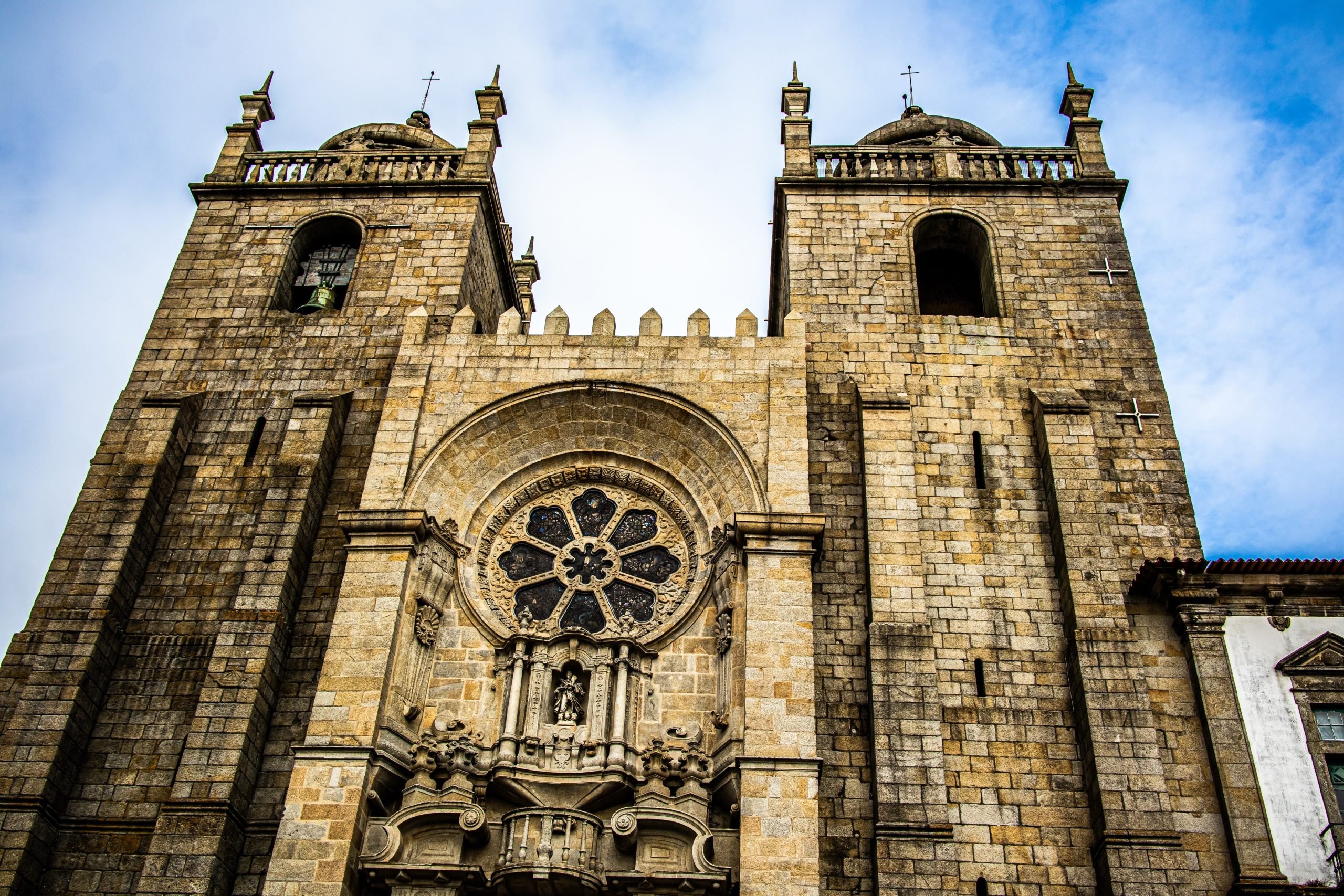
4. The Old Cathedral of Coimbra
The construction of the Old Cathedral of Coimbra was likely overseen by the same architect who oversaw the construction of Lisbon Cathedral, which is why the two have quite a similar appearance.
However, the building in Coimbra surpasses the one in Lisbon in terms of Romanesque elements and preservation. It is, in fact, the only building in Portugal that has retained much of its original elements.
The Old Cathedral in Coimbra has a fortress-like exterior. It has high crenelated walls, narrow windows, and a tower-like structure in the center of the Western facade. The portal and the window on the facade are Romanesque in style and feature some Arabic and Pre-Romanesque motifs. The facade is also adorned with thick buttresses.
The North facade has a Renaissance portal, which was built in the 16th century. The main chapel is Romanesque, as is the northern one. The southern chapel was rebuilt in a Renaissance style. The roof lantern one can see over the transept features Romanesque and Baroque elements.
The nave of the Old Cathedral in Coimbra has two aisles. It is covered by barrel vaulting, while the lateral aisles are covered by groin vaults. The interior column capitals are decorated with vegetable, animal, and geometric motifs and patterns. The cathedral has around 380 heavily decorated capitals. Today, they are considered the most remarkable testament of Romanesque sculpture. The cloister was built sometime later, during the transition from Romanesque to Gothic, which is why it retains elements of both.
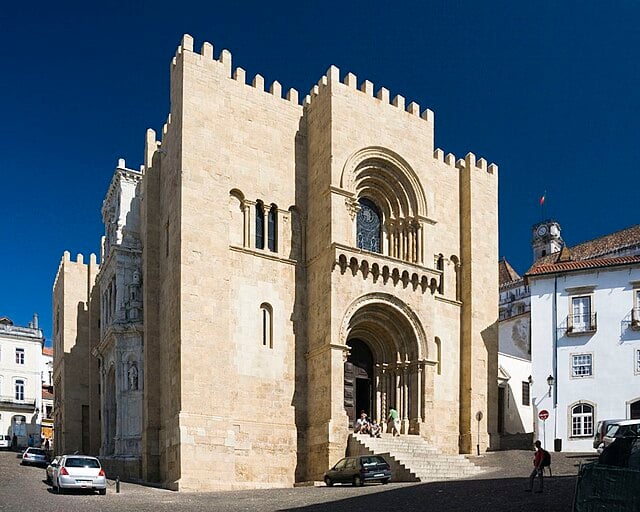
5. The Round Church at the Convent of Christ
The Round Church at the Convent of Christ is predominantly Romanesque. It has a 16-side polygonal structure and features strong buttresses and round windows.
The interior has a round octagonal structure. The capitals of the columns are among the country’s few well-preserved Romanesque treasures. They feature vegetal and animal motifs, which may have been sculpted by the same artists who worked on the decorations of the Cathedral of Coimbra.
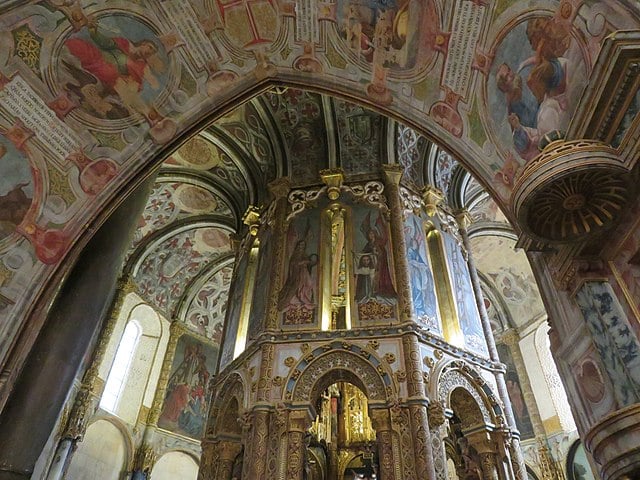
6. The Romanesque Church of Rates
The Monastery of Rates isn’t as renowned among tourists as other buildings we mentioned in our guide because it’s a hidden gem in Northern Portugal.
However, one cannot deny the importance of its church in our discussion – it is one of the oldest, most well-preserved churches in Portugal adorned with Romanesque elements.
The Church dedicated to St. Peter of Rates, also known as the Romanesque Church of Rates, has a fortress-like appearance, lacks heavy decorations, and features a Romanesque portal.
7. Church of Santa Eulalia of the Monastery of Arnoso
Yet another hidden gem – the Church of Santa Eulalia of the Monastery of Arnoso. It is located in Vila Nova de Famalicão in the Braga District.
The original building actually dates from the 7th century. However, it was destroyed in the 11th century by the Moors. Later on, King Garcia II ordered the reconstruction of the church. It was eventually rebuilt in a Romanesque style, which is preserved until the present times.
The church has a Romanesque nave, a barrel vault, a rectangular apse, and blind arches. The round arches on the wooden portal are decorated with geometric patterns and zoomorphic elements.
8. Domus Municipalis of Bragança
As mentioned earlier, churches weren’t the only structures built in a Romanesque style. Domus Municipalis of Bragança proves this – it is now one of the few buildings in Portugal whose Romanesque elements were preserved.
Some historians argue that the building may have served as a place for public meetings. Other specialists believe it may have actually been a cistern rather than a Municipal house. Whatever its purpose, one cannot deny that the structure is a Romanesque treasure.
It was likely built in the first half of the 13th century. The structure has an irregular pentagon shape and was built using granite blocks held together by mortar. The wooden roof is supported by three arches. The walls are thick, and the windows are small. Corbel decorations are also Romanesque.

Other Romanesque Buildings in Portugal
If you have time and are interested in exploring the various dialects of the Portuguese Romanesque, we’ve prepared a list of landmarks that are worth checking out.
- The Benedictine Monastery of Castro de Avelãs is located in Castro de Avelãs, 3 km away from Bragança. The church’s Romanesque elements are incredibly well-preserved, and the structure is an important historical landmark. Specialists argue that this particular building falls within the Mudejar expression of Romanesque architecture.
- The Church of São Salvador is located in Bravães, Ponte da Barca, and features multiple Romanesque elements, particularly in its sculptures and portal. Its tympanum depicts Christ in the Glory of Heaven accompanied by two of His apostles. There’s also a figure of Mary and angel Gabriel.
- The Castle of Pombal is located in Pombal, Leiria. It is a Romanesque fortress built in the 12th century.
- The Church of São Vicente de Sousa is located in Felgueiras, Porto, and stands out as a major Romanesque monument.
- The Monastery of Santa Maria de Pombeiro is located in Felgueiras, Porto, and is noticeably Romanesque in style. It is one of the most iconic Benedictine monasteries in Northern Portugal. The building is an example of the late Romanesque style combined with early Gothic floral motifs.
- The Church of São Pedro de Ferreira is located in Ferreira, Porto. It has a single nave and a semi-circular transept. The decorations and sculptures of this church are of great diversity, featuring influences from the Braga Cathedral, as well as the Zamora Cathedral and the San Martin de Salamanca in Spain.
- The Monastery of the Saviour of Paço de Sousa is located in Penafiel, Porto. It is an iconic monastery of the Benedictine Order. The church is an example of nationalized Romanesque, which combines pre-Romanesque elements and Romanesque motifs used in Porto and Coimbra.
- Igreja de Santo André da Vila Boa de Quires is located in Marco de Canaveses in Northern Portugal. Its portal is similar to that of the above-mentioned church in Penafiel and features vegetal motifs, whereas the corbels are adorned with bovine heads.
- The Church of Saint Mary is located in Sintra and is an excellent example of the architectural style that marked the transition between the Romanesque and the Gothic.
- Ponte de Vilela is a medieval bridge located in Arcos de Valdevez.

